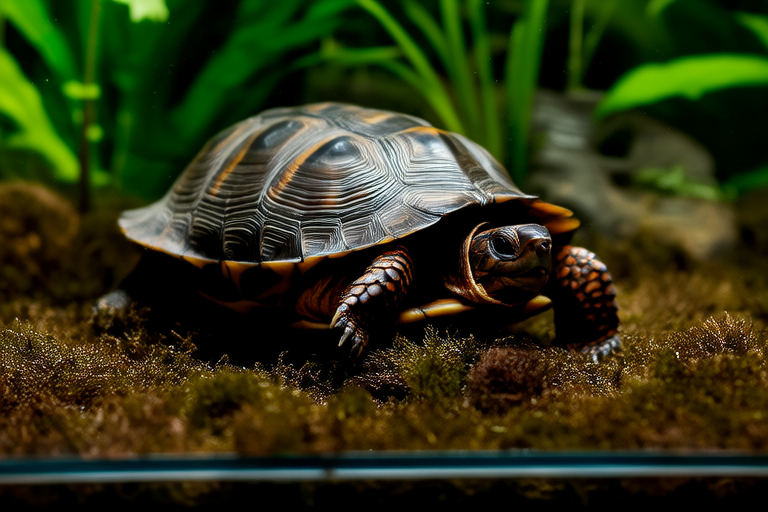Creating the Ideal Habitat for Three-Striped Box Turtles
Welcome to the world of three-striped box turtle care! These captivating reptiles are known for their unique appearance and gentle demeanor, making them a popular choice among turtle enthusiasts. However, providing an optimal environment is crucial for their health and well-being. This guide will walk you through the steps to create the perfect habitat for your three-striped box turtle, ensuring they thrive in captivity.
Habitat Size
The first step in setting up a suitable habitat for your three-striped box turtle is to choose an appropriate enclosure size. Adult turtles require ample space to move around freely. A general rule of thumb is to provide at least ten square feet of floor space per adult turtle. For younger or smaller turtles, a minimum of five square feet is recommended. Larger enclosures allow for better exercise and reduce stress, promoting overall health.
Substrate Type
Selecting the right substrate is vital for maintaining a clean and healthy environment for your turtle. Many turtle keepers prefer a mix of coconut fiber and sphagnum moss due to its moisture-retaining properties and ease of cleaning. Avoid using gravel, sand, or small pebbles as these can pose choking hazards if ingested. Additionally, substrates like bark chips or wood shavings may harbor harmful bacteria or mold, so they are not recommended.
Temperature and Humidity Requirements
Maintaining the correct temperature and humidity levels is essential for the health of your three-striped box turtle. The ideal temperature range for the basking area should be between 85°F and 90°F (29°C to 32°C). Meanwhile, the cooler side of the enclosure should stay around 75°F to 80°F (24°C to 27°C). Use a reliable thermometer to monitor these temperatures accurately.
Humidity levels should be kept between 60% and 80%. Proper humidity helps prevent respiratory infections and encourages healthy shedding. You can achieve this by misting the enclosure daily and providing a water dish large enough for your turtle to soak in.
Lighting Needs
Proper lighting is crucial for the health and well-being of your three-striped box turtle. Full-spectrum UVB lighting is necessary for calcium metabolism and vitamin D synthesis. Ensure that the UVB bulbs are positioned correctly above the basking area and replace them every six months to maintain their effectiveness. In addition to UVB lighting, provide a heat lamp to create a basking spot with the appropriate temperature range.
It’s also important to offer a photoperiod that mimics natural daylight cycles. A twelve-hour light cycle is generally sufficient, but you may adjust it based on the time of year and your turtle’s behavior.
Hiding Spots
Providing hiding spots within the enclosure is essential for reducing stress and promoting a sense of security. Turtles need places where they can retreat when feeling threatened or simply want some solitude. You can use various materials such as cork bark, half logs, or specially designed turtle caves. Make sure the hiding spots are easily accessible and provide adequate ventilation.
Water Area Setup
A dedicated water area is a must for three-striped box turtles. They spend a significant amount of time soaking and swimming, which aids in digestion and skin health. The water area should be large enough for your turtle to fully submerge itself comfortably. Ensure that the sides of the water area are gently sloped to allow easy entry and exit. Maintain clean water by changing it regularly and consider using a water filter if necessary.
Diet Integration Within the Habitat
Integrating feeding areas into the habitat can help mimic natural foraging behaviors. Place food dishes in different locations throughout the enclosure to encourage movement and exploration. Offer a balanced diet consisting of commercial turtle pellets, fresh vegetables, fruits, and occasional live prey like crickets or mealworms. Ensure that any live prey items are appropriately sized for your turtle to avoid ingestion difficulties.
Safety Precautions
Taking proper safety measures ensures the longevity and well-being of your three-striped box turtle. Regularly inspect the enclosure for any potential hazards such as sharp edges or loose hardware. Clean the habitat thoroughly and frequently to prevent the buildup of harmful bacteria. Additionally, handle your turtle gently and with care, as excessive handling can cause stress.
Supervise children when interacting with the turtle and educate them about proper handling techniques. Always wash your hands before and after handling the turtle to minimize the risk of zoonotic diseases.
Conclusion
Caring for a three-striped box turtle is a rewarding endeavor that requires dedication and attention to detail. By following the guidelines outlined in this article, you can create an ideal habitat that promotes the health and happiness of your beloved pet. Remember, a well-maintained enclosure and a balanced diet are key factors in ensuring your turtle thrives in captivity. Happy turtle keeping!
